|
Know anyone who
can benefit for this? Share! |
|
|
 |
 |
 |
|

What are
the fundamental 4 legs of the cyclist's
chair. And why you can't do without them
The foundations of a
well-rounded, healthy cyclist rest
on 4 fundamentals. We call these fundamentals the 4 legs of the
cyclist chair because all 4 are needed to achieve the proper
balance. When all fundamentals are taken care of, a cyclist is
able to operate at his/her best, putting in a solid performance
after the other, for the long haul.
Like a chair, if any one of
the legs is missing, the balance becomes precarious. If any two of
the legs are missing, the balance becomes impossible.
In this article we discuss what
the 4 legs are, how to execute a proper plan to attain all four
and how to prioritize them on your way to achieve the ideal
balance.
|
The 4
legs of the cyclist chair in order of priority:
-
Bike Fitting
-
Training and Coaching
-
Nutrition
-
Equipment
|
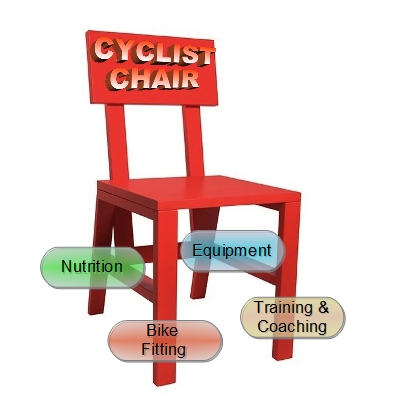 |
How does this apply to you?
When planning your training and
performance improvements, you should consider the 4 legs of the
chair as your guideline and check point to know you are building
yourself a stronger cyclist.
We list here the 4 legs in the order
of importance, as you begin to build/evaluate your cyclist
chair. This is not just for beginners. Ideally, all individuals
new to cycling would follow these recommendations; but often,
it's the more experienced cyclists who will benefit from the 4
legs.
This article should function as
a guideline if you are already in an advanced stage of cycling.
It may help you uncover where there is a need for improvement if
you plateaued in your performance, as the 4 legs of the cyclist
chair may help reveal any gaps in your preparation or practice
of cycling.
|
1) Bike Fitting. |
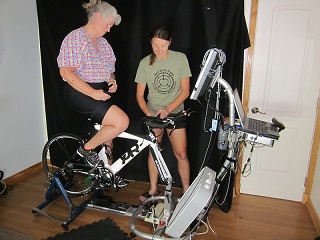 |
We think that fitting is
paramount. Not because it is our primary business. But because
we know that if your bike doesn't fit right, you don't
feel right; your performance is severely reduced. No matter how well trained you are or how
well you eat or how light your bike is... If your bike fit is off, so
are you.
You know that most people who
ride bicycles also talk about aches and pains - or feeling
that something is missing in their best
performance. Some came to accept that recurrent pain is just
part of the cycling experience and will encourage you to just
ride through it, get use to it: "Build your sit bones."
they say.
But you know that no amount of
toughening yourself has really resolved the problem. The
underlying issues are still there. What you are seeing is the result of an improperly
fit cyclist culture that has come to accept pain as part of the
equation of bike riding. This is a culture that has not quite
yet caught up to
the reality of modern bicycle riding.
Why is bike fitting so
important? Wouldn't the level of fitness be more
important?
Thinking that having fitness
and power is more important than being in harmony with your
bike, is tantamount to thinking you can put a race car engine in
an economy car and expect it to win a 24 of Hours of Lemans. The
chassis is not going to perform. And it's not going to hold
together. Your engine is your legs. Your chassis is your body -
not your bike. (Gear-head and motor-head cyclists should appreciate this
comparison...).
If you want to hold together
and
keep your performance level high for lifetime, you need to get
fitted.
|
Bike fitting achieves
the all-important goal of improving performance
through efficiency and bio-mechanical alignment.
This ensures a healthy pedal stroke, free of injuries
and aches/pains caused by repetitive use and adaptations
to a poor bike fit. And it does so by
being custom tailored to you, your application (road,
tri, mtb, etc.) and your current condition (fitness,
injuries, pains, flexibility, etc.). It strikes
the delicate balance between giving you the performance
of a lifetime and a lifetime of performance.
If you are not bio-mechanically
safe, no matter how light is your bike; how much you can lift in
the gym; how far you try to go; how often you ride. Eventually,
you will succumb to a set back. In some severe cases, an ill-fitted cyclist may
not be able to complete a distance or may have to stop riding
because of a repetitive use injury and the time required to heal. In essence,
if the bike doesn't
fit right, you won't ride right and you won't be right.
Bike fitting has become the
very foundation of cycling and the benchmark for performance.
The science of fitting has made such progress that nowadays bike
fitting is the very tool by which cyclists gain an edge,
ride well into their aging legs and extend their
distance/efforts to new levels.
3D motion capture technology
like Retül has allowed fitters to see cyclists behaviors while
in motion -in real time- and
modify them for the better with unparallel accuracy. The details
of an interaction between a cyclist and the bike are so fine
(better than 1 mm of accuracy!),
riders can be maximized to incredible levels of power gains or
injury recovery/avoidance.
But it's not only the power and
aerodynamic improvements that benefits a cyclists. It's the
prevention and recovery from injuries that make a difference.
With a proper bike fit, riders who sustained injuries can come
back to their bicycles. An experienced bike fitter with a Retul
3D motion capture system can achieve a fit position that neutralizes the
ill-effects of the injuries and their resulting adaptations.
|
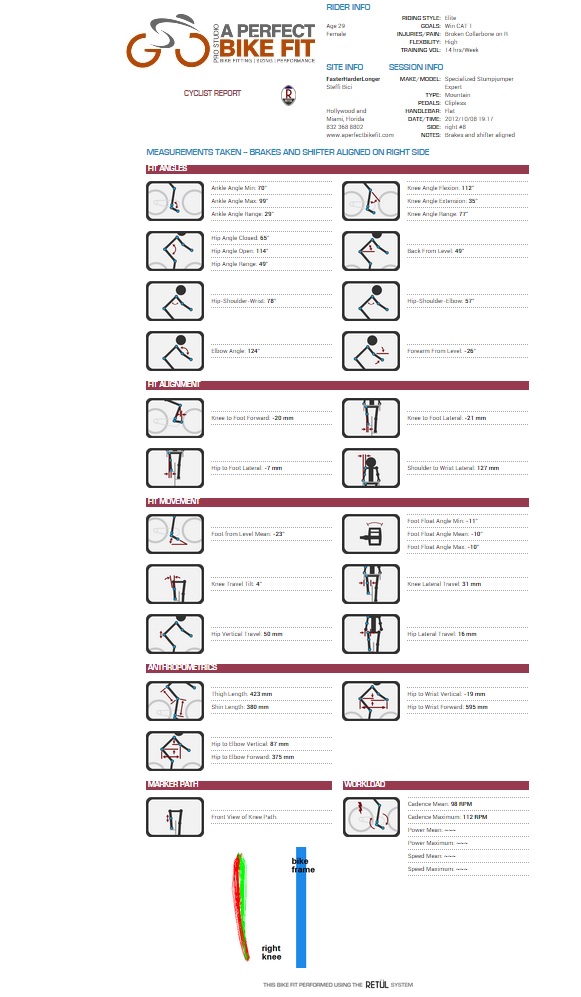
Retül bike fitting is a seriously scientific tool to
improve your performance. All this data is calculated
while you are in actual motion. No stopping. |
You can spend more than the
cost of a bike fit on a shiny, super-light carbon seatpost. It will make your
friends go: "Uhhh! Ahhh!" when standing still at the coffee
shop. But it won't make you faster. Or more comfortable. Or help
recover from an injury.
Unlike expensive bling, bike
fitting gives your performance a clear edge over others. Your
friends won't have the breath to say "Uhhh! Ahhh" at all!
(Maybe after the ride the will enquire about what you are
doing...)
And best of all, bike fitting
is the best bang for the buck, providing
well-proven performance improvements that last -just like you
will.
|
2) Training and Coaching |
 |
You may have the best bike. You
may be comfortable on your bike. And you may eat clean. But if
you don't train -and train properly- nothing else matters -other
than your bike fit. There
is no substitute for hard work. Even the best fit in the world
is not going to give you the legs.
Training, just like bike
fitting, has risen to a new level in the last few years.
Knowledge trickling down from the formerly secretive Pro circles
has benefited the everyday cyclists. Sports medicine has made a
huge leap forward due to the miniaturization and proliferation
of technology in this field. Thanks to new studies done
with sophisticated equipment, we learned the very secrets of
human performance. This, in turn, has given coaches the
benefits of a very advanced knowledge of human performance and
the ability to apply it to your situation.
|
New and affordable equipment
like advanced power meters, GPS and
heart rate monitors have put
powerful training tools in your hands. This, in turn, has
further empowered coaches to closely monitor, evaluate and
design training plans customized to you.
Training tools alone
are not a guarantee for success. Do you know how to read
the loads of data from your power meter or HR/GPS
monitor?
Knowing how to train,
is the key. You don't want to go out there and just ride
hard, record your data and expect to see results.
Data for data's sake is nothing but a bunch of numbers.
Say, you hit 600W max today. That's good. But how was
your 5 minute average Watts? And your 20 minutes? What
was the recovery time in between threshold efforts? How
many intensity training days have you had this week?
Last 2 weeks? Last month?
Those are some of
the questions you need to ask. They lead to the ability
to put together a targeted training plan, one that
includes periods of intensity, followed by rest, in a
process called training periodizaztion.
You
need to have a training plan: a daily, weekly, monthly,
quarterly and annual schedule of workout at specific
intensity and rest
blocks.
With your GPS head
unit recorded data, coaches can evaluate
your performance using sophisticated software. Then, they can quantify your
workload and design plans uniquely suited to you. The
succession of building blocks of increasing and
specific intensity
with alternate periods of resting has become the
standard for improving performance while avoiding over
training. |

Modern training tools give you and your coach the data
needed to design your training plan |
|
But data streams alone
are not enough to prescribe the right workloads. Modern coaching depends strongly on
performance testing
as a mean for creating a baseline for your abilities and
improvements over time. With
performance testing,
specific workloads can be prescribed for your
training blocks and can be adjusted as your body
responds to them.
Long gone are the days of HR
one-size-fits-all training zones. Remember? The heart rate zone
table that everyone used in the 90s and early 2000s? The
one that specified heart rates based on age...?
We learned how
inaccurate that system was. Today, your HR and
Power zones are
calculated specifically for you at the end of every training block.
Your HR zones vary as fast
as you progress through your training. And only testing can
determine where you are at. |
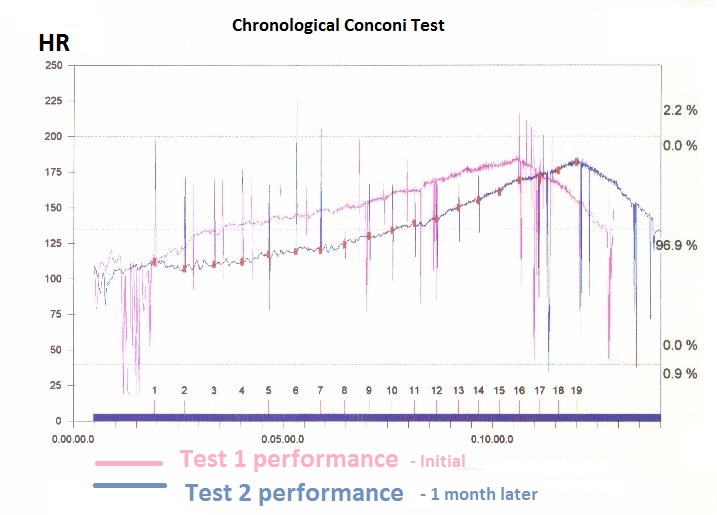
Chronological performance testing gives you the data to
compare and plan your training to exact specifications.
You can read more about performance testing
here. |
|
The sequence of
stretch loads
in your training zones and rest blocks periodize your training
and produce results that have no equal.
This sequence is
somewhat of an art to get right. Get it wrong and you
are likely to overtrain.
Overtraining is
all-too-well established in American cycling. Blame it
on our mentality: it's ingrained into us that more is
better. The result? US Domestic Pros get spanked by their
Euro rivals who train less.
You don't have to be
a Pro to overtrain. Actually, the most severely
overtrained athletes are the common every day cyclists.
If 10 miles was good, 40 was better. So, 100 must be
best...
And so, cyclists are
out there pounding the pavement, driving themselves into
oblivion because they just train hard and long, hoping
it would work. And missing out on other fun things in
life too.
A good coach will
give you just the right amount of work to
do, given your goals and the realities of your life
-giving you back your time to live a life full of variety,
not just training.
And with
periodic assessments aided by performance
testing, your training is set on track to
achieve your life best performance -and maintain it. |

A coach can periodize your training in blocks of workout
and rest. This is important for your health and utmost
performance development. |
If you want to progress
quickly and safely while staying healthy, a good coach and/or a
good training plan should be a strong consideration. It's a
relatively smaller investment as compared to some fancy
equipment. But unlike that über-light carbon/Ti component, this
is actually going to make you faster.
|
3) Nutrition. |
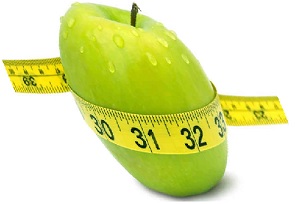 |
In cycling, when we mention
nutrition, most people think of sports drinks and energy bars.
We have been well-conditioned to the idea of replenishing
electrolytes lost in the sweat and getting shots of energy
through little shiny packets. But nutrition goes well beyond the
quick fix of an energy or recovery drink. And the benefits of
nutrition can produce such performance results, they are well
worth the efforts.
Especially for those cyclists
who carry around a few extra pounds, proper nutrition can be the
gateway to much success on and off the bike. For others, it can
make a difference between cardiovascular disease,
hyper-pressure, diabetes and a long life free of disease. For
others yet, it can mean achieving the best performance of a
lifetime. And for another group of people yet, a diet rich in
anti-oxidant is vital to stave off their propensity for tissue
inflammation.
We all know the benefits of a
good diet. Improved mood; successful weight management; abundant
energy. But as diets go through fad after fad, it becomes
difficult to choose a good regimen and stick to it. To add to
the challenge, we are in an ever-increasing fast food society,
full of preservatives, pesticides, hormones/steroids, sugars and
salts.
If your diet doesn't seem to produce the desired results; you
feel devoid of energy; your weight yoyos... it's time to get help
from the professionals.
Nutritionist, just like coaches
benefit from an unprecedented knowledge of the human body and
can dial-in your food intake without robbing you of the pleasure
of eating. Much of the failure of diets is simply due to this
issue. But today, nutritionists can work out a proper
meal plan specific to you thanks to the system "diet by blood type".
| This diet
recognizes that ancestry plays a vital factor on how our bodies
process food. Written in our DNA is our ancestral origin and
with it, our enzymatic heritage. The
stomach of a European may be well suited to certain
starches like pasta and rice, but will struggle
tremendously with, for example, a central/south-American
diet, rich in corn.
The body is
unable to fully process the food intake that is not
indigenous or compatible with our ancestor's original
diet, no matter how far removed we are from that
original geographic location. This was a huge "a-ha!"
moment for the dietetic community as it helped explain
why some people gain weight eating breads, while others
stay perfectly skinny.
The ability to
create certain enzymes is responsible for the digestion
of food and is they key in nutrients extraction. If the
food is not compatible with our enzymatic stock, we have
issues with vitamin deficiencies, weight gain/loss and
trouble with glycemic control. |

Don't eat what your body can't process |
That explains why some people struggle with carbs;
some with
proteins; some with certain type of grains, fruits and vegetables.
It unlocks the reason why some people seem more prone to
inflammation than others.
Knowing which type you are goes a long way in making your diet
plan a complete and satisfactory meal that achieves your goals.
A nutritionist is able to build a diet that is full in flavor,
diversity and satisfaction.
And yes! Cheating is allowed.
If you have a northern Euro, Icelandic enzymatic profile and
love tacos... well... Go ahead. It won't kill you. Maybe just not for
breakfast, lunch and dinner. Just keep it real.
|
4) Equipment. |
 |
We left equipment for last, not
because it's the best, but because it really fits here. Too
often we focus too much on equipment. We obsess over weight
and bling. We get lost in the adulations of our fellow
cyclists for our new equipment. We don't think twice about
dropping $300 for a carbon seatpost or a fancy carbon saddle,
just to save 50 grams. All it matters is that the bike looks
good. But does it make you faster?
While there is nothing wrong
with having the best of the best and blinging out our bikes, the
performance improvement from equipment alone almost pales in
comparison to the other 3 legs.
Of course, there is a huge
difference in an entry-level bike and a top-of-the-line bike. A
good bike can bring out the best of you. In some cases the
quality of the equipment makes the experience and the overall
performance significantly better. But never quite as much as a
good training plan, loosing some weight (if necessary) or, most
of all, a good
bike fit. We need to keep that in perspective.
When resources are at premium,
we'd rather ride a little less bling and invest the difference
in ourselves, our performance and our fit. But if money is not
an option, then, seeking the best equipment for your application
can really step things up a notch.
In some cases dropping 1 lb off
your bike can mean improving several minutes off a steep climb. In
other cases, a set of aero wheels can mean dropping minutes off
your Time Trial or bike split time (providing no cross winds). A
good suspension fork will get you through the rocks much faster.
Sure, you can do
an Ironman with a road bike and clip-on aero bars, but a proper
Tri bike may make a difference in your aerodynamics and
overall performance.
It's not only the equipment
that makes a difference, but also having the right bike size and
geometry can make a huge difference. If the bike is too big or
small, no matter how light, aero or decked out, your experience
won't be a satisfactory one.
That's why the process of
bike sizing is paramount before buying an new bike
(see here).
Can you trust your bike shop to sell you what's right for you as
compared to what they need to move off the floor? Can you trust
yourself with not coveting the nice bike that's one size too
big, but is on sale?
Bike Sizing
is like insurance before you invest into a new bike.
Do you know what is the right
size/geometry for your body?
|
There is a lot that goes into
selecting the right size. And it's intimately connected to
relationship between the seat tube angle, the
length of the cranks and your leg anthropometric measurements. Did you know that?
Stock bikes make the best they
can at being a great compromise between the size of the frame, its
geometry and size of components - all based on the size of the
average cyclist.
What if you don't have an
average leg length ratio? Long femurs? Or you work out a lot and
have really wide shoulders... |
|

|
GOOD
READ:
Read the
article about bike sizing and the benefits on
performance and cost savings.
You may learn the little dirty
secret to bicycle geometry and sizing. |
|
If you have never been fitted
or sized, you may be riding the wrong size
bike/geometry/components combo. Cranks are a typical example.
|
Crank length is directly
related to your ability to generate power. It also helps in not
putting weight on the foot in the non-active part of the
pedal stroke (AKA, the back side of the stroke or 180 to 360
degrees of revolution) which causes power absorbtion. It improves the ease with which you
clear the top of the pedal stoke, when your leg is at its
highest point and the hips at their most compressed. Finally, it
is directly related with the position of the knee as compared to
the pedal axle - a key parameter for power and knee health.
The length of the crank and the
seat tube angle of a bike's geometry play a dance of performance with each other.
Find the right combination and it's pure performance bliss. Get
it wrong and you'll be left with that nagging feeling that the bike
never feels right. |

Variable Length Cranks are used to evaluate the best
combination of crank length vs. bicycle geometry. |
|
Bike sizing is the process by
which you get fitted into a "fit bicycle" to
determine all these parameters. A fit bicycle is a funky
contraption that looks like a bike and changes in shape and size
to simulate any bike geometry you desire.

It's equipped with a
variable length crank, a variable geometry stem and variable
width bars, so an experienced fitter can find the
exact combo of size, geometry and crank length for you.
|
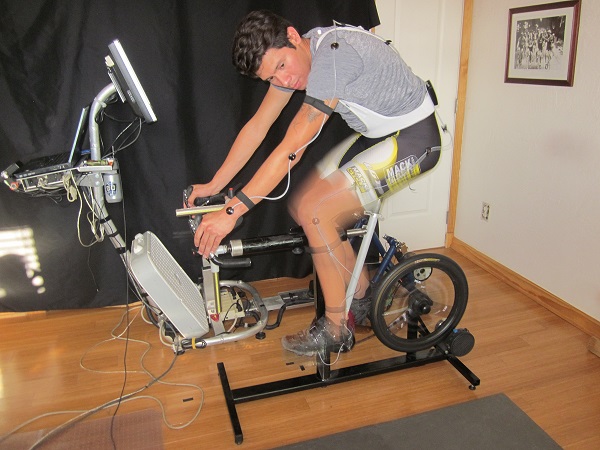
A rider on a
sizing bicycle, getting fitted to find optimal
size/geometry |
|
Once you have the information
from a sizing session, it's shopping time.
Sizing gives you a
geometry chart with a wealth of information, like reach, stack,
handle bar reach, seat tube angle, etc. (see a
full sample here).
This
allows you to compare many brands and models to your ideal
geometry/size, so you can narrow down bikes that work for you
and those that don't.
It also helps you determine if some parts swaps are
needed to change an OEM built as it shows off the bike floor.
The handlebar width, the cranks length and the seapost
offset (setback or not) are often the most common parts
to swap out.
Knowing this before
buying a bike is very useful. Most bike shops will
happily work with you and swap parts before the
final sale to make sure they give you the bike that you
need.
Some manufacturers
like Trek, Giant and Specialized even have a custom
build program that lets you spec out the bike on their
web site and they will build you the bike to your exact
specs. Some have a 30 day components swap guarantee.
With this much
support from your favorite bike manufacturer, there is
no reason why you shouldn't be riding the right bicycle
for you. And with the help of the bicycle sizing
process, you should be in really good hands. |
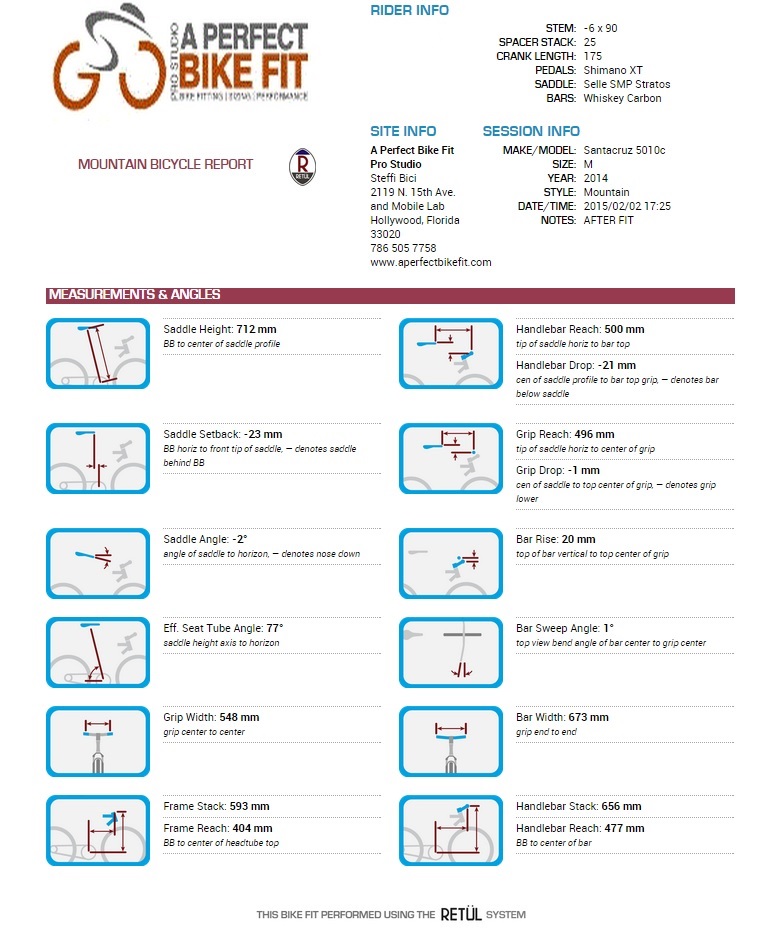 |
Usually, a good bike fitting
studio will have you back after you buy the new bike and do the
final fitting onto the bicycle you actually purchased - so you are all-powerful
and comfy in your own bike, not just the bicycle sizing
simulator. This is what we do in our practice because we
learned it yields the best possible result for your performance
and comfort.
There are a few nuances that a
sizing bicycle cannot emulate successfully enough to make a
sizing fit the final bike fit (that's the shortcoming of some
bicycle fitting systems that use only the bike sizing process;
but that's a story for other times). In bike fitting
the devil is in the details and many issues with comfort come
from small adjustments. Transferring the measurements from a
sizing bike to an actual bike does not yield the level of fine
detail accuracy we want for you.
For example: the Q-Factor of
the cranks and pedal combination varies by crank brand model.
The reach and drop of the handlebar also changes by brand and
model. The setback of the seatpost does as well. The sizing bike
simulator uses "typical" components to simulate the many
variations of all OEM components out there. It does a great job of helping
us determine the correct sizing, but not the minute nuances that
are seen on the final product. Things like the angle of the
shifter hoods can change by 1 or 2 degrees and make a difference
in hands comfort, due to the handlebar profile. That's why
we do a two-step process, where the final fit is on your new
bike.
It's a rather thrilling
process that makes bike shopping an educated search and sends
you on a performance mission. It ensures you'll buy the
right bike.
There is a time a place for
equipment. But it is only after the other 3 legs are on solid ground
that we should really turn our attention to it. And maybe, just
maybe, if our other 3 legs are strong - really, really strong -
you can
actually find someone to provide you with your dream equipment.
You never know...
OUR BELIEF:
"You don't have to be a Pro to get a bike fit. Everyone who
climbs into a bike deserves to have a great experience,
regardless of their fitness, expertise or equipment level."
A Perfect Bike Fit Pro Studio
Love your ride. Get a bike fit.